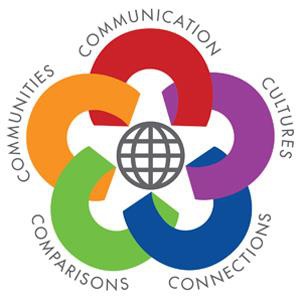The World-Readiness Standards for Learning Languages create a roadmap to guide learners to develop competence to communicate effectively and interact with cultural competence to participate in multilingual communities at home and around the world.
The World-Readiness Standards for Learning Languages define the central role of world languages in the learning career of every student. The five goal areas of the Standards establish an inextricable link between communication and culture, which is applied in making connections and comparisons and in using this competence to be part of local and global communities.

The five “C” goal areas (Communication, Cultures, Connections, Comparisons, and Communities) stress the application of learning a language beyond the instructional setting. The goal is to prepare learners to apply the skills and understandings measured by the Standards, to bring a global competence to their future careers and experiences.

![]() COMMUNICATION
COMMUNICATION
Communicate effectively in more than one language in order to function in a variety of situations and for multiple purposes
Interpersonal Communication: Learners interact and negotiate meaning in spoken, signed, or written conversations to share information, reactions, feelings, and opinions.
Interpretive Communication: Learners understand, interpret, and analyze what is heard, read, or viewed on a variety of topics.
Presentational Communication: Learners present information, concepts, and ideas to inform, explain, persuade, and narrate on a variety of topics using appropriate media and adapting to various audiences of listeners, readers, or viewers.
![]() CULTURES
CULTURES
Interact with cultural competence and understanding
Relating Cultural Practices to Perspectives: Learners use the language to investigate, explain, and reflect on the relationship between the practices and perspectives of the cultures studied.
Relating Cultural Products to Perspectives: Learners use the language to investigate, explain, and reflect on the relationship between the products and perspectives of the cultures studied
![]() CONNECTIONS
CONNECTIONS
Connect with other disciplines and acquire information and diverse perspectives in order to use the language to function in academic and careerrelated situations
Making Connections: Learners build, reinforce, and expand their knowledge of other disciplines while using the language to develop critical thinking and to solve problems creatively.
Acquiring Information and Diverse Perspectives: Learners access and evaluate information and diverse perspectives that are available through the language and its cultures.
![]() COMPARISONS
COMPARISONS
Develop insight into the nature of language and culture in order to interact with cultural competence
Language Comparisons: Learners use the language to investigate, explain, and reflect on the nature of language through comparisons of the language studied and their own.
Cultural Comparisons: Learners use the language to investigate, explain, and reflect on the concept of culture through comparisons of the cultures studied and their own.
![]() COMMUNITIES
COMMUNITIES
Communicate and interact with cultural competence in order to participate in multilingual communities at home and around the world
School and Global Communities: Learners use the language both within and beyond the classroom to interact and collaborate in their community and the globalized world.
Lifelong Learning: Learners set goals and reflect on their progress in using languages for enjoyment, enrichment, and advancemen
![]() Reference
Reference
ACTFL ![]() https://www.actfl.org/publications/all/world-readiness-standards-learning-languages
https://www.actfl.org/publications/all/world-readiness-standards-learning-languages
All documents may be accessed at http://www.actfl.org/publications/all/national-standards-foreign-language-education.





 留言列表
留言列表